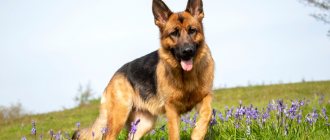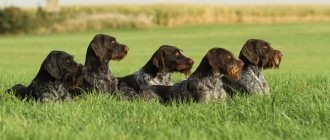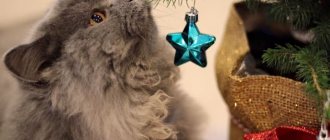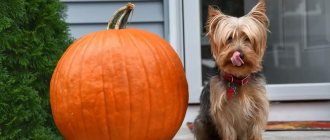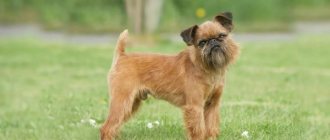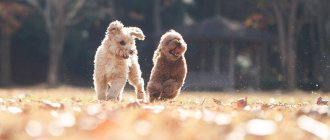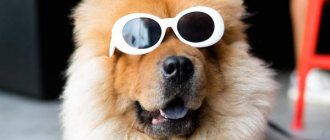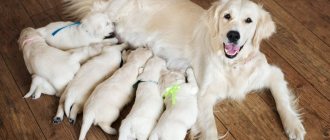The German Drahthaar breed is a dog that is distinguished by its hard coat and increased activity. Literally, the dog cannot sit in one place for more than 10 minutes. In this regard, it is recommended to own one for those who are ready to give the animal the necessary attention. In addition to hyperactivity, this breed has a pronounced ability to learn. In just a few days, the dog will learn the necessary behavior patterns.
The German Drathaar breed is a dog that is distinguished by its hard coat and increased activity.
Basic parameters of a devoted dog
In addition to the characteristics mentioned, the Drahthaar dog breed has a high life expectancy . Many cases have been recorded when the animal exceeded the mark of 15-18 years. Dog handlers hasten to make an important disclaimer here. The lifespan of a dog largely depends on the quality of care and nutrition. The more time the owner devotes to the pet, visits the veterinarian, selects high-quality food, etc., the less likely it is that pathological changes will develop in the animal’s body. It is not recommended to have an active dog for those who are not ready to constantly monitor its health.
In addition to the characteristics mentioned, the Drathaar hunting dog has the following parameters:
- maximum height of a male – 68 cm;
- maximum bitch height – 61 cm;
- weight – from 27 to 33 kg;
- flexible character.
Important tips for keeping an animal:
- It is prohibited to keep a dog in an apartment;
- Walking for at least 2-3 hours a day is recommended.
Training is carried out only by the owner, otherwise an important psychological connection will not be formed
Before you decide to get a four-legged friend, you need to think carefully and decide whether you can provide the Drathaar with the right regime. The less physical activity a dog has, the faster he becomes depressed. Depression does not have the best effect on his health, so you should not expose your animal to such a risk.
This breed needs physical activity from a psychological point of view. Dog handlers have proven that idleness provokes behavioral changes for the worse. You'll be lucky if the dog just becomes apathetic. There have been many recorded cases of how a lack of physical activity provoked attacks of anger. The amount of physical activity varies for each individual dog, so you should consult your veterinarian.
brief information
| Breed name | Drathaar |
| Country of origin | Germany |
| Time of appearance of the breed | Late 19th century |
| Breed type | Hunting dog |
| Adult dog weight | 23-27 kg (females), 26-32 kg (males) |
| Height (height at withers) | 56-62 cm (females), 60-68 cm (males) |
| How long do they live? | 12-14 years old |
| Popular nicknames | Racer, Socrates, Bruno, Nika, Bertha, Alpha |
Young animals quickly reach maturity
Beginners in the field of cynology should not indulge themselves in illusions regarding puppies. At first glance, it seems that the cute little furballs will remain the same weak and fluffy for a long time. In fact, from the moment of birth to the beginning of active life, a dog of this breed takes about 6-7 months. By the age of 12 months, the dog requires regular physical activity. That is why, when purchasing drathaar puppies, you need to be aware of your own actions.
Life expectancy largely depends on the quality of care and nutrition
It is recommended to start physical exercises with young animals at the age of 5-6 months. The recommendations of the canine service are taken as a basis. If you do not have the necessary training experience, it is better to seek professional help. Even a minor mistake can lead to major behavioral changes. Do not forget that lack of physical activity at a young age poses a great threat to the health of puppies.
Origin
The homeland of the drathaar is Germany. His ancestors are considered to be Old German wire-haired pointers: at the end of the 20th century. breeders crossed them with the Pointer, Poodle, Airedale Terrier and Griffon in order to develop a new hunting breed. Purebred breeding of Drahthaars began in the 1920s. At the same time, the standards for this breed were approved.
Due to its hunting qualities, the Drahthaar quickly gained popularity in other European countries, but during the Second World War the breed's population declined greatly. The remaining Drahthaars, along with the Kurzhaars (German shorthaired pointer), were subsequently used to restore the numbers of these dogs. The Drahthaar came to Russia at the beginning of the 20th century, but here the breed had its own history and was also revived after the Great Patriotic War thanks to the selection of wire-haired pointers imported from Europe.
Gallery: Drahthaar hunting dog breed (25 photos)
The educational process takes time
You need to know that the characteristics of the breed include a point about the need to follow a certain sequence of actions when it comes to the issue of training. Any deviations from the recommendations of dog handlers will lead to sad results. Nature has determined that the black dog is stubborn. Any attempts to apply pressure by force of one’s own will will end in vain.
That is why, when training an animal, you need to rely on cunning. The minimum duration of training is 4-5 months. The specified time period is quite enough to transfer the necessary skills to the animal and consolidate them. Training is carried out only by the owner, otherwise an important psychological connection will not be formed.
It is worth remembering that a hunting dog is strongly attached to its owner. If you decide to use the services of a professional trainer, then the presence of the owner is mandatory.
The dog must remember who is in charge. At the same time, the owner himself needs to learn to feel the animal. Only in this case will the person and the pet coexist harmoniously.
From a psychological point of view, during the preparation stage, the dog is taught to trust not only the owner, but also those around him. At the same time, dog handlers urge not to go too far. The main task is to deprive the animal of the pathological fear that everyone around is planning to harm it. According to dog handlers, here lies the main problem in the interaction between people and dogs. Looking at its size, many are scared. It seems to them that such a formidable appearance hides a similar disposition.
Behavioral model
From the point of view of a four-legged animal, such behavior is a pronounced sign of aggression. Conflict situations often arise on this basis. Properly organized educational work will help to avoid them. It is carried out with triple power in cases where there is a child next to the dog. The animal must know how to behave towards the baby.
As already mentioned, life with a drathaar dog will not be easy for many reasons. First of all, we are talking about the psychological aspect. So:
- the animal gets along well with adults, which cannot be said about kids;
- the breed is an excellent watchman and bodyguard, but it is prone to bouts of loneliness;
- the dog dominates over representatives of other breeds if there is more than one;
- any stranger will not pass by this dog unnoticed;
- the animal may become too shy if mistakes were made at the preparation stage;
- at the age of one year, the four-legged friend will stand next to the owner, waiting for prey to appear during the hunt;
- dogs are distinguished by increased endurance.
How to choose a puppy
When choosing a puppy, you should pay attention to the fact that it has clean eyes, nose and ears, and there are no signs of diarrhea or parasite infestation. Healthy animals have a round but not bloated belly and good coat. The puppy should be active, but not excessively. He does not shy away from his brothers and sisters. The smallest and largest puppy in the litter are not the best choice.
Similar breeds
Externally similar breeds are the German smooth-haired and long-haired pointers. They also fall into the category of hunting dogs.
The need for regular medical examination
The more attention a person pays to the health of a pet, the less chance the latter has of getting sick. Due to increased physical activity, the animal runs the risk of various types of damage. An unsuccessful jump, a fall, or a muscle strain are just a few of the medical problems. Those who have experienced this know how much the entire list of medications necessary for rehabilitation therapy costs.
In second place in frequency are pathologies caused by an incorrectly formed diet. On the one hand, people know that an active dog requires a lot of energy. On the other hand, the animal’s nutrition sometimes leaves much to be desired. It is imperative to visit a veterinarian. The doctor will conduct an examination and give specific recommendations to the owners.
Veterinarians have compiled a list of the most common medical pathologies of the breed:
- diabetes mellitus – formed against the background of a genetic predisposition or as a result of an incorrectly selected diet;
- otitis and other pathologies of the auricle;
- violation of the integrity of the hip joint;
- volvulus;
- increased gas formation;
- pathological changes in the structure of the eyelid;
- melanoma in various forms;
- aortic stenosis;
- complete or partial rupture of ligaments;
- cataract;
- decreased visual acuity;
- malignant and benign oncological neoplasms;
- atrophy of the organs of vision and hearing;
- raw eczema.
As can be seen from the above list, the animal is predisposed to many dangerous diseases. In this regard, a person should regularly bring their pet to the veterinarian's office for preventive purposes . Only in this case can pathologies be diagnosed at an early stage. Thanks to the achievements of modern veterinary medicine, most diseases can be cured at an early stage.
Disease susceptibility
Drathaars are predisposed to dysplasia of the elbow and hip joints, rupture of the anterior cruciate ligament, Wobbler syndrome (a neurological syndrome associated with a genetically determined disorder in the structure of the cervical vertebrae), and injuries to the musculoskeletal system.
Drathaars can be susceptible to inflammatory skin diseases, pododermatitis, otitis, and eczema. They are prone to developing sensitive digestion for no particular reason and, like many other large breeds, torsion.
Timely contact with a veterinarian, as well as proper care and maintenance of the drathaar will preserve the dog’s health for many years and help avoid the development of many diseases.
Key rules for caring for active dogs
Most textbooks on the Drathaar (description of the breed, etc.) detail the basic rules, the observance of which is mandatory. This list begins with the need to thoroughly comb the dog at least twice a day. The indicated amount increases by 2 times during the traditional molting season. If this is not done, specific wool balls will form. The more there are, the more problems they will cause the animal.
Water treatments are carried out strictly as needed. You shouldn't bathe your dog too often. Firstly, the animal can easily catch a cold. Secondly, some representatives of the breed develop an allergic reaction to specialized cleaning products. Speaking about hygiene products, dog handlers hasten to draw the attention of owners to an important fact in all respects: when choosing shampoos for dogs, you need to take into account the type of skin and coat of the animal. You should not think that only hygiene products for people need to be chosen with passion. It is enough to visit the veterinarian 1-2 times for him to determine the acceptable list of personal hygiene products that must be followed. Otherwise, there is a high risk of provoking an inflammatory process due to skin irritation.
In addition to the above recommendations, there are several more:
- Dogs that regularly take part in hunting must undergo a thorough examination. Increased attention is paid to the condition of the ears and paw pads.
- Visits to the dentist occur at least twice a year. Everything here is the same as with people. The more accurately the doctor’s recommendations are followed, the less the furry patient’s teeth will worry.
- At least once a year it is necessary to check the condition of the eyes and claws. Due to increased physical activity, injuries often occur.
If even minor deviations in your health occur, you should immediately seek qualified medical help. The faster this is done, the less likely the disease is to provoke pathological changes in the dog’s body.
Questions from an Inexperienced Drathaarist
My friend got a drathaar puppy. He is an experienced dog breeder, but he has never had to deal with raising, raising and training a cop. Therefore, remembering that I had been involved in dog breeding work for many years at the MOOiR, but having an exaggerated opinion of my experience with drathaars, he bombarded me with questions about this breed.
Unfortunately, these questions often puzzled me. The fact is that my ideas about drathaars developed in Soviet times, and they were based on dogs of Mooirov breeding.
My friend also remembered the drathaars of that time, that is, domestic breeding, therefore, being left without a dog, he chose this breed. Before getting a puppy, he carefully studied the standard and made sure that he was doing the right thing.
This is exactly the kind of dog he needed. Victor was attracted not by “outstanding training abilities”, not by an innate tendency to fetch, not by the ability, like other cops, to stand and search with a shuttle.
He saw the advantage of the drathaar, first of all, in the fact that he is well dressed, not afraid of the cold and mosquitoes. Both were sufficient in the north, where Victor had to spend a lot of time and hunt. Indeed, according to the standard, this breed has a coat length of 3–6 cm along the body, the belly, chest, back, shoulders and hips are well protected and covered with longer hair, and, what is especially important, there is a soft, denser undercoat along the entire body, neck and hips. in the cold season and, even more so, when kept outside. Even on the ears and crown of the head, the fur reaches one and a half centimeters in length.
The balanced nature of these dogs was very, very important to my friend. The mobile type of behavior, that is, nervous activity, made them easily controllable, and the unwanted exciting effect could easily be inhibited. This, in addition to convenience during training, made the drathaars pleasant in the hostel. A balanced type of behavior, logically, is indirectly related to the strong, dry type of their constitution.
Associated with the character, as Victor remembered, and which he found confirmation in the standard, was the search for the drathaar “at a moderately fast gallop, at times turning into a trot.” This my friend considered the most acceptable for himself.
I know that at least five people who either own Drathaars themselves, or have recently had the opportunity to get to know them closely and see them at work, furiously urged Victor not to buy a puppy of this breed. They said that today's draaths have become crazy, hard-to-control dogs, with whom it is not easy both in the field and in everyday life, that they can literally drive the owner crazy and wear out all his nerves.
All these acquaintances believed that the problem of the breed came from the West, along with spontaneously imported, unknown dogs, which became our producers. They are sure that worthy elite dogs do not come to us - this is an incredibly expensive pleasure, accessible to very few.
I won’t describe Victor’s ordeals, I’ll just say that he was unlucky in terms of the character, clothing and behavior of the dog, which was gifted with a crazy temperament and search at cosmic speeds. That is, at one and a half years old, she has a rather dry-strong type of constitution and is completely devoid of those breed advantages on which he pinned his hopes.
Like a whirlwind, tirelessly rushing through open fields, it scares away all living things, not having time to slow down and make a stand. With all that, this is a very nice creature, spontaneous, with an expressive, light-eyed, bearded muzzle, beautiful, regular lines, pedigree head and a magnificent last. The close-fitting, smooth, devoid of undercoat makes it possible to admire the well-developed, prominent muscles.
When asked why a shorthaired pointer needs a beard, Victor seriously answers: so that I can have the pleasure of wiping it off after every meal.
However, as we see, the comrades turned out to be right in many respects. This means that the breed is unstable and, when choosing a puppy, you are taking a pig in a poke. But are their judgments about the causes of this phenomenon correct?
Many people say about Victor’s dog that in appearance it is almost ideal and meets modern requirements for coat, which are dictated by the trendsetter for drathaars, the country from which they come - Germany. This, apparently, is where the expression “Deutsch Drathaar”, which has become widespread among some of the newly-minted Drathaarists, comes from, as opposed to the Drathaars of domestic breeding.
One might think that the original “breed-forming” stock of Drahthaars (as well as Shorthaired Pointers), with which we carried out breeding work, was of high quality, since initially it was based on adult dogs exported as “trophies” from Germany. The “high-profile” German nurseries were named, from which the Drahthaars were seized.
I’m afraid to say categorically, but it seems to me that most of Victor’s questions and problems are caused by the fact that recently our drathaars have changed a lot.
Victor is surprised why some of the active drathaarists take show exhibitions seriously, and obsequiously - the opinions of the foreign judges invited to them. Some consider the examination of visitors to be more thorough due to the fact that the guests saw many foreign dogs. This position is incomprehensible.
I am sure that our hunting dog breeding, that is, the practice of testing, assessing the breeding qualities of pointing dogs and their breeding, has reliable traditions and has always been at an incomparably higher level than abroad. It turns out that the Western bias, which turned out to be so harmful for the Russian education system, poses a real threat to our domestic dog breeding, threatening to destroy it, depriving it of its roots.
In this regard, Victor really liked the articles published in ROG by the famous drathaarist and kurtshaarist from the Pskov region, Andrei Larin. He competently and emotionally defends the domestic practice of breeding these breeds.
I remember how surprised I was when I first came across the fact that the dog, an Irish setter, with excellent external breed characteristics, was not included in the mating plan. Then, respected Irishman, game scientist Alexander Sergeevich Rykovsky, with whom I was closely acquainted, said: “How could it be otherwise! After all, this dog was taken from abroad, and we know almost nothing about its ancestors. As a sire, she is dangerous for the breed and can greatly harm it.”
And what immediately comes to mind is the recent conversation about the peculiar breed style of work of continental cops with Vadim Zhibarovsky, well known to all readers of ROG, literally a week before he passed away.
Once at a competition, while exhibiting his magnificent shorthaired pointer, he admired the work of the dogs together with a famous dog handler and a very authoritative member of the judging committee. They sent the drathaar in, which beautifully, correctly, combed the meadow at great speed with a classic shuttle. “Pointer!” - said the judge. This is how he expressed his attitude towards the work of a dog that does not correspond to its breed characteristics.
I got the impression that there is complete confusion in the breed now. The expert article I came across in ROG cannot be taken seriously, but at the same time it demonstrates the level of perception that some Drathaarists have about the breed.
The author quite seriously argues that each of our regions needs its own drathaars, the coat of which would correspond to climatic conditions (in the south - naked, in the north - clothed), that is, they say, it would be nice to have a kind of “multiple breed” breed. He apparently doesn’t know what the breed standard is.
I once asked a man, a big and active enthusiast of Drathaars, who takes an active part in their breeding, on what, in his opinion, is breeding work for this breed based now? Are there lists - a wide, complete database of producers and does it include all, or almost all, dogs of the Moscow region and regions of the European part? Are at least dogs registered in various hunting societies of Moscow and neighboring regions used for breeding? And I realized that it’s more likely no than yes.
I can’t figure out on my own why “Deutsch” clubs of Drahthaars and Shorthaired Pointers were organized within the same breed, that is, to destroy it. To establish connections with foreign countries and enter the international arena? Or to be able to decide without interference, without any plans, how, whom, when and with whom to breed from dogs of foreign, that is, practically unknown, from the point of view of hunting dog breeding, origin?
After talking with Victor about the drathaars, the question involuntarily arose: how are things going with the shorthaired pointers? What are dogs like after the “Deutsch Shorthaired Pointer” was identified within a single breed, what are the consequences?
I found a partial answer to the question whether shorthaired pointers have changed in “ROG”, in the story of the extremely sensitive author Maxim Lukashik, who is in love with the breed. The answer is already contained in the title of his essay - “Diversity of Kurzhaars”. Under such a “soft” title, he talks about the same problems that Victor faced after he got a puppy to replace his wonderful Sandra.
He involuntarily compares the young, already beloved dog with her, and the comparison is not yet in her favor. Excessive ardor, obstinacy and stubbornness have appeared, which are difficult to calmly withstand, that is, everything is like the drathaar Victor. M. Lukashik says that the high speed of searching the land does not please him at all.
It is significant that he mentions V. Zhibarovsky and agrees with his opinion that speed and fidelity of instinct are antagonists. True, the author explains all the misunderstandings by an unsuccessful choice of line. But linear breeding aims to concentrate the best breed qualities in the offspring, through the competent selection of sires.
I understand that I am touching upon, perhaps, a sore subject in an amateurish manner. I don’t want to offend any of the fans of continental cops, of which there are a lot and are becoming more and more numerous. But this makes the questions I raised more relevant.
I hope that experienced dog breeders associated with these breeds will not ignore this note.
Source
You need to think it over again before purchasing
It’s easy to understand that not everyone can make such a friend. It is required to devote a lot of time to the animal every day. We are talking about the minimum required amount of physical activity, proper upbringing, etc. Do not lose sight of the correct diet. Even a slight deviation will not have the best effect on the pet’s health.
Due to the constant desire to move, the dog spends a large amount of energy. In order to replenish it, you need to regularly feed your furry friend properly. Newbie dog owners are advised to consult a veterinarian. In each case, the menu is formed based on a comparison of many indicators of the body’s functioning.
Regular exercise and proper care will help keep your dog in excellent physical shape. If a person does not feel the strength to spend time training a living creature, then he should refuse to buy it. It is better to pay attention to calmer breeds, which, unlike the drathaar, are allowed to be kept in a city apartment.
Advantages and disadvantages
Advantages of the breed:
- devotion to the owner;
- pliability to training;
- energy and activity;
- excellent security and hunting characteristics;
- unpretentiousness in maintenance and care;
- goodwill.
Disadvantages of the breed:
- excessive nervousness and lack of attention;
- caution and shyness when communicating with strangers;
- the desire to dominate and control one's territory.
The Drahthaar breed is great for active people who love movement and sports. The advantages of purchasing such a pet are much greater, and the disadvantages can always be smoothed out with the right approach of the owner and the innate restraint and intelligence of the dog.
